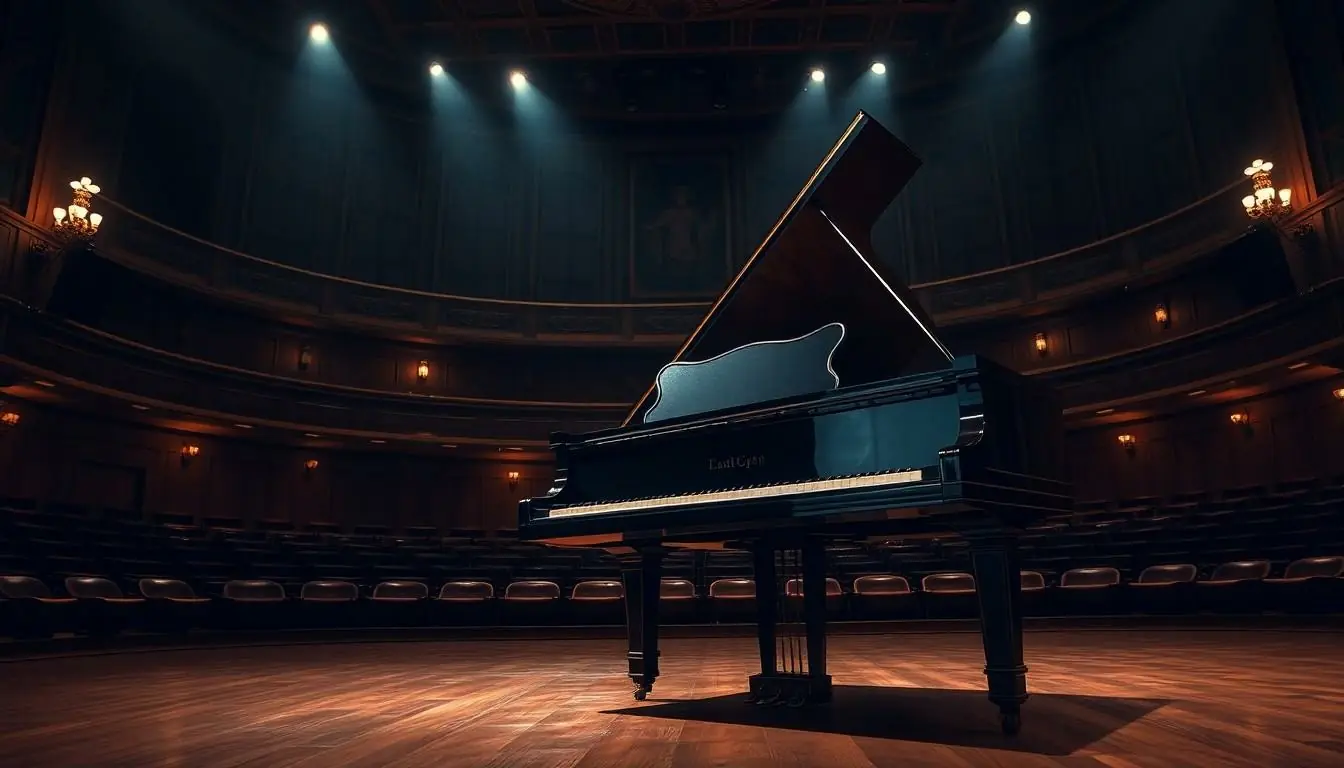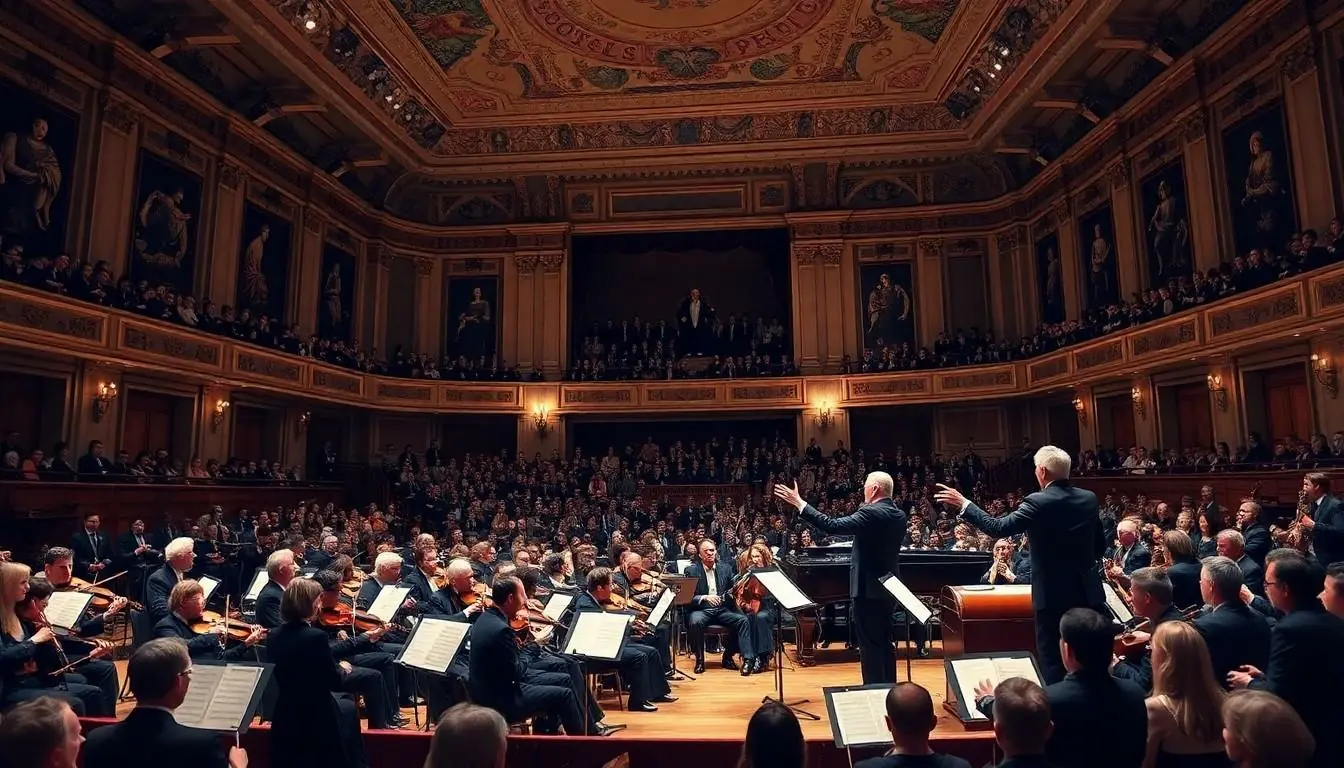Western classical music isn’t just a genre; it’s a grand tapestry woven with the threads of history, emotion, and creativity. From the soaring symphonies of Beethoven to the intricate fugues of Bach, this musical tradition has captivated listeners for centuries. It’s the kind of music that can make you feel like a genius while you sip your coffee, even if you’re just pretending to understand the difference between a sonata and a symphony.
Table of Contents
ToggleOverview of Western Classical Music
Western classical music encompasses a vast repertoire spanning over a thousand years. This genre features distinct periods, including the Medieval, Renaissance, Baroque, Classical, Romantic, and Contemporary. Each era contributes unique styles and forms that shape the musical landscape.
Notable composers remain central to this tradition. Figures like Johann Sebastian Bach established foundational techniques, while Ludwig van Beethoven expanded emotional expression and structural complexity. Their works continue to resonate across generations, influencing countless musicians and genres.
Musical forms play a significant role in Western classical music. The symphony, concerto, opera, chamber music, and sonata showcase varied instruments and structures. Performances often highlight virtuosity and ensemble collaboration, creating rich auditory experiences.
Harmony and melody form the bedrock of composition. Composers utilize intricate chord progressions and memorable motifs to evoke emotions. Elements such as counterpoint enhance texture, allowing multiple independent voices to interact seamlessly.
Cultural contexts also impact Western classical music. It flourished in royal courts, churches, and concert halls. Patronage systems contributed to the creation of monumental works while influencing stylistic developments.
Listening to Western classical music can foster a deeper appreciation of its complexities. Music lovers often find themselves drawn to its intellectual depth and aesthetic beauty. Understanding key historical moments and stylistic shifts enhances one’s listening experience, illuminating the artistry behind the notes.
Historical Development

Western classical music has evolved through several distinct eras, each contributing to its rich tapestry. These eras showcase a variety of styles and innovations, influencing generations of musicians and composers.
The Medieval Era
During the Medieval era, roughly 500 to 1400, music developed primarily within churches. Gregorian chant emerged as a dominant form, characterized by monophonic melodies. Notably, composers like Hildegard of Bingen and Guillaume de Machaut began to experiment with rhythm and harmony. Secular music gained prominence through the rise of minstrel traditions. Notable instruments such as the lute and vielle started to appear, enriching the musical landscape.
The Renaissance Period
The Renaissance period, spanning 1400 to 1600, marked significant advancements in musical notation and polyphony. Composers such as Josquin des Prez and Palestrina emphasized intricate vocal harmonies. The use of form became more structured, evident in the development of the madrigal and motet. Instrumental music gained importance, with the emergence of ensembles. This era laid the foundation for expressive dynamics and textural variation, shaping future compositions.
The Baroque Age
The Baroque age, from 1600 to 1750, introduced emotional depth and dramatic expression. Composers like Johann Sebastian Bach and George Frideric Handel contributed to the creation of intricate fugues and oratorios. The emergence of opera transformed how stories were told through music. Ornamentation and improvisation flourished, showcasing a performer’s creativity. This period highlighted the importance of contrast in dynamics and instrumentation, setting the stage for further explorations in music.
The Classical Period
The Classical period, beginning around 1750 and ending in 1820, shifted focus to clarity and balance. Figures like Wolfgang Amadeus Mozart and Joseph Haydn emphasized form and melody. The symphony and string quartet became standard forms, providing structure to compositions. The use of sonata-allegro form allowed for thematic development. Innovations in orchestration enhanced the colors of the music, inviting audiences into a refined listening experience.
The Romantic Era
The Romantic era, from 1820 to 1900, emphasized individualism and emotional expression. Composers such as Ludwig van Beethoven and Frédéric Chopin explored the depths of human emotion through their works. Programmatic music became popular, telling stories through instrumental pieces. The expansion of the orchestra allowed for richer sounds and textures. This period encouraged a personal connection between the composer and the listener, often invoking a sense of longing or nostalgia.
The 20th Century and Beyond
The 20th century brought a myriad of diverse styles and movements in Western classical music. Innovations include jazz influences and the rise of modernism, with composers like Igor Stravinsky and Arnold Schoenberg pushing boundaries. Minimalism and postmodernism emerged, showcasing varied approaches to composition. Technology began to play a role, influencing how music was created and distributed. Contemporary classical music continues to evolve, reflecting the complexities of modern society.
Key Composers
Western classical music features numerous influential composers who shaped its landscape. Each composer introduced unique styles and techniques that continue to resonate today.
Johann Sebastian Bach
Johann Sebastian Bach (1685-1750) epitomizes the Baroque era’s complexity and depth. He mastered counterpoint, employing intricate harmonic structures within his compositions. Famous works include the “Brandenburg Concertos” and “The Well-Tempered Clavier,” which showcase his technical prowess. Beyond instrumental music, Bach’s choral works, such as the “Mass in B minor,” reflect profound spiritual expression. His influence extends far beyond his lifetime, inspiring countless musicians across genres.
Ludwig van Beethoven
Ludwig van Beethoven (1770-1827) marked the transition from the Classical to the Romantic period. His compositions exhibit a deep emotional range, often challenging traditional forms. Works like the “Eroica Symphony” and “Piano Sonata No. 14” highlight his innovative use of structure and melody. Beethoven’s ability to convey personal struggle and triumph resonates with audiences, making his music timeless. He expanded thematic development, impacting future generations of composers significantly.
Wolfgang Amadeus Mozart
Wolfgang Amadeus Mozart (1756-1791) stands as one of the most prolific composers in history. His prolific output includes over 600 works, ranging from operas to symphonies and chamber pieces. Iconic masterpieces such as “The Magic Flute” and “Requiem” showcase his melodic ingenuity and mastery of form. Mozart’s ability to blend simplicity with depth captures the essence of human emotion. His influence endures, shaping classical music’s evolution for centuries.
Claude Debussy
Claude Debussy (1862-1918) revolutionized music with his impressionistic style. He emphasized vivid colors and textures rather than traditional harmonic progression. Pieces like “Clair de Lune” and “La Mer” transport listeners to evocative soundscapes. Debussy’s innovative approaches, such as using nontraditional scales and rhythms, challenge conventional boundaries. His work paved the way for modern composers, solidifying his legacy in the transition to contemporary music.
Influence on Other Music Genres
Western classical music significantly impacts various genres. Its intricate structures and harmonious principles influenced jazz. Composers like Duke Ellington incorporated classical techniques, blending them with improvisation.
Pop music also draws from classical traditions. Artists such as Elton John and Queen utilize orchestral arrangements to create a richer sound. These influences often manifest in melodic lines reminiscent of classical compositions.
Rock music showcases elements borrowed from classical genres as well. Led Zeppelin and Pink Floyd integrated orchestral instruments and progressive structures, enhancing emotional expression within their music. The use of complex time signatures in progressive rock demonstrates classical music’s rhythmic innovations.
Film scores frequently reflect classical influences, shaping the emotional landscape of cinema. Composers like John Williams and Hans Zimmer draw inspiration from the dramatic styles of composers like Richard Wagner and Gustav Mahler. Their work illustrates the enduring legacy of classical music in storytelling.
Additionally, electronic music embraces classical elements. Artists such as Max Richter use classical samples and motifs within modern compositions. This fusion creates a unique sound that bridges the past with contemporary music.
Hip-hop artists also pay homage to classical music. Sampling classical pieces in their tracks highlights the genre’s eclectic nature. For example, Nas’s use of Beethoven’s “Für Elise” in his song “I Gave You Power” merges classical themes with modern storytelling.
These examples demonstrate the extensive reach and adaptation of western classical music across diverse genres. The influence remains evident as artists continue to explore and experiment with its rich heritage.
Western classical music remains a vital force in the cultural landscape. Its intricate compositions and emotional depth continue to resonate with audiences across generations. The influence of legendary composers like Bach and Beethoven is undeniable, shaping not only the genre but also inspiring countless artists in various musical styles.
As listeners explore this rich tradition, they uncover layers of artistry that enhance their appreciation. The evolution of Western classical music reflects a dynamic interplay of history, culture, and creativity. This timeless genre invites everyone to experience its beauty, whether through a symphony hall or a personal playlist. The journey through its history reveals a world where music transcends time and connects people in profound ways.




